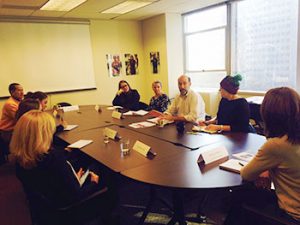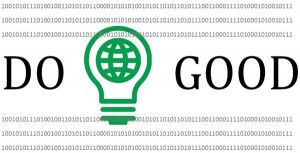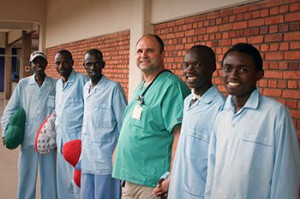Megatrends And Their Impact On Our World
Posted on December 2, 2014.
By Charlotte Dawkins
 In a world where information constantly bombards us, where there is always something “trending,” the concept of megatrends is something that PricewaterhouseCoopers (PwC) is looking at closely. PwC opens Global Washington’s 6th Annual Conference on Wednesday, December 3 with a presentation of their recent study outlining five megatrends.
In a world where information constantly bombards us, where there is always something “trending,” the concept of megatrends is something that PricewaterhouseCoopers (PwC) is looking at closely. PwC opens Global Washington’s 6th Annual Conference on Wednesday, December 3 with a presentation of their recent study outlining five megatrends.
PwC defines megatrends as “macroeconomic forces that are shaping the world” and states that they are “factual and often backed by verifiable data.” The five megatrends include society’s biggest challenges and opportunities, and are as follows:[1]
- Accelerating Urbanization
- Climate Change and Resource Scarcity
- Demographic Shifts
- Shift in Global Economic Power
- Technological Breakthroughs
Continue Reading
KUOW’s Ross Reynolds Interviews Global Washington Member One By One’s Carolyn Anderman about Obstetric Fistula
Posted on November 25, 2014.
Ross Reynolds interviews Carolyn Anderman, director of international programs for One By One, a Seattle-based group helping women in Africa recover from a devastating birth complication called obstetric fistula. Affected women are often shunned in their communities for a condition that can be fixed with a $500 operation.
Listen to the interview at http://kuow.org/post/500-operation-can-change-lives-african-women.
GlobalWA On the Ground: SE Asia Children’s Foundation
Posted on November 24, 2014.
By Jesse Lee
This is the second in a series of articles written by the Adventure in Focus team. While traveling throughout Southeast Asia, AIF is documenting the projects of several GlobalWA member organizations that are working on the ground in the region. Jesse submitted this article from Thailand, while working with Bill Taylor of SE Asia Children’s Foundation.
Bill Taylor, the energetic and affable founder of SE Asia Children’s Foundation, is retired. You wouldn’t know it by spending time with him, though. He spends three to four months each year in Southeast Asia, visiting the projects he works year-round to fund. His foundation, a long-time Global Washington member, is helping children – especially girls – break the cycle of poverty into which they were born and from which they are not likely to escape without outside assistance. Bill’s positivity is infectious and his love for his work is present in everything he does. A former management consultant, he uses the knowledge and skills that he’s accumulated throughout his career to help build capacity, train leaders and strategize for organizations in Southeast Asia that are helping at-risk children obtain a stable and nurturing environment.
Continue Reading
Roundtable Recap: Creativity, Sustainability and Strategy in NGO Fundraising
Posted on November 17, 2014.
By Alyssa Brooks, the Snow Leopard Trust, a Global Washington member
 On November 13, a group of executive and program directors gathered for Global Washington’s ED Roundtable to discuss a challenge that all NGO leaders face: fundraising. Brad Rutherford, Executive Director of the Snow Leopard Trust (SLT), led the lively discussion and talked about the success he’s had in his almost 15 years with the Trust.
On November 13, a group of executive and program directors gathered for Global Washington’s ED Roundtable to discuss a challenge that all NGO leaders face: fundraising. Brad Rutherford, Executive Director of the Snow Leopard Trust (SLT), led the lively discussion and talked about the success he’s had in his almost 15 years with the Trust.
“Executive Directors wear many hats,” stated Rutherford. “Fundraising is similar in that it’s never one size fits all.” Rutherford described SLT’s three main sources of fundraising – Snow Leopard Enterprises, donors and subscriptions, and annual events.
Continue Reading
Expanding Opportunity for Farmers in Paraguay
Posted on November 11, 2014.
by Mark Coffey, chief investment and operating officer, Global Partnerships, a Global Washington member

Mark Coffey (center) meets with a group of 75 Paraguayan farmers. These farmers have formed an association that sells to BioExport. They have also banded together to purchase the tractor pictured. They are hoping that their livelihoods will improve, and that they can one day become a cooperative. Photo © Global Partnerships.
Last week I traveled to Paraguay to meet with social enterprises, agricultural producers and a government official as part of our research into new investment opportunities. Nearly a quarter of Paraguay’s population lives below the poverty line, but the country’s underdeveloped economy is currently experiencing rapid economic growth. With this kind of growth comes the chance to catalyze and expand opportunity for people living in poverty. As I flew over much of the small, land-locked country in a tiny Beechcraft plane, I noticed the flatness of the land, its many rivers, and the countless tracts of well-watered but unused farmland. It is evident that Paraguay’s agricultural sector has tremendous potential for growth.
Social enterprises
During my five days in Paraguay I was able to visit four social enterprises:
- BioExport and ARASY, two agricultural organizations that provide technical assistance and access to (and processing for) export markets. They serve smallholder farmers growing sesame and chia as well as more traditional products like cotton and rice;
- Fundacion Paraguaya, which provides credit and integrated services to people living at the base of the economic pyramid; and
- Elevate Business, which provides business training to young, emerging small and micro entrepreneurs (SME’s) who have high potential to absorb and implement concepts for markedly improving their business. Some of their clients include Fundacion Paraguaya’s clients. In the past decade, many farmers with land holdings under 8 hectares (approximately 20 acres) have realized the benefit of enriching their soil and their incomes by converting from one traditional crop (such as rice, beans, corn, and cotton) to higher priced products such as sesame and chia. Thanks to the efforts of social enterprises such as BioExport and ARASY, hereafter referred to as “outgrowers,” there is a developing export market for these higher-priced products. To scale the opportunity to more farmers, we need to build up an ecosystem where access to financing, technical assistance and markets is readily available.
To read the full article, click here.
Depriving Women Farmers of Land Rights Will Set Back China
Posted on November 4, 2014.
By Tim Hanstad, President & CEO of Landesa and board member of Global Washington
China is launching what is perhaps the most ambitious land registration system in history, seeking to document and protect property rights to more than one billion plots of land across the countryside.
Read more: http://www.scmp.com/comment/insight-opinion/article/1631165/depriving-women-farmers-land-rights-will-set-back-china
How Can Data Be A Tool for Social Good?
Posted on November 3, 2014.
By Christine Pinho, Data Analyst at Big Water Consulting, a Global Washington member

We live in the age of data. It’s a well-used buzzword, a trending topic among a wide range of people from marketers and social media experts to business analysts and tech nerds. This is for good reason: data does help organizations manage themselves more efficiently and plan better.
Continue Reading
Ghana’s Oil for Food Initiative: Finding a Solution to the Resource-Rich Paradox
Posted on October 27, 2014.
By Liv Froehlich
Ghana is a nation that has always produced some of the world’s most essential national resources, from gold to cocoa. However, when the country discovered 3 billion barrels of sweet crude oil beneath its soil in 2007, it drastically changed the country’s standing in the global economy. With expected revenues averaging $1 billion per year, the question on everyone’s mind was how the country would choose to spend this revenue windfall.
On Sept. 22, Oxfam America, Global Washington and Seattle University’s Poverty Education Center hosted a panel discussion about Ghana’s Oil for Food Initiative. This initiative focuses on directing oil revenue towards the promotion of sustainable and inclusive development through agriculture modernization.
Continue Reading
Healing Hearts in a Country with Plenty of Broken Ones
Posted on October 20, 2014.
By Sam Wolff
 The 1994 Rwandan genocide crippled the country, leaving it torn by violence and death on a massive scale. The recovery from this atrocity was made more difficult because an estimated 75 percent of the Rwandan medical community was murdered or forced to flee the country, which left the healthcare system in shambles. The situation has since improved, however, there are still only about 400 physicians to treat a country of more than 11 million people.
The 1994 Rwandan genocide crippled the country, leaving it torn by violence and death on a massive scale. The recovery from this atrocity was made more difficult because an estimated 75 percent of the Rwandan medical community was murdered or forced to flee the country, which left the healthcare system in shambles. The situation has since improved, however, there are still only about 400 physicians to treat a country of more than 11 million people.
Healing Hearts Northwest (HHNW), a Spokane-based Global Washington member, works to remedy this situation. Founded in 2008, HHNW began with a meeting in Rwanda’s King Faisal Hospital, which then inspired subsequent medical missions to perform operations on Rwandan patients. HHNW continued to provide medical training and equipment so that the hospital could better manage acute patient care and better handle complex patients. HHNW hosts annual training seminars and lectures for Rwandan nurses and physicians, and obtains funding for equipment that improves the capabilities of Rwandan medical facilities.
Continue Reading
MovingWorlds Opens Platform to Connect Skilled Volunteers with Opportunities Worldwide
Posted on October 15, 2014.
By Blair Hanley Frank
MovingWorlds today opened a new online matching service designed for people who want to travel abroad to make a difference through volunteering.
The platform is focused on what MovingWorlds calls “Experteering” – connecting people with specific skill sets to projects that could use the experience they have. Whether that’s mentoring startups or creating websites, it’s a way to help people to maximize their impact as a volunteer.
Read more: http://www.geekwire.com/2014/movingworlds-opens-platform-help/
 In a world where information constantly bombards us, where there is always something “trending,” the concept of megatrends is something that PricewaterhouseCoopers (PwC) is looking at closely. PwC opens Global Washington’s 6th Annual Conference on Wednesday, December 3 with a presentation of their recent study outlining five megatrends.
In a world where information constantly bombards us, where there is always something “trending,” the concept of megatrends is something that PricewaterhouseCoopers (PwC) is looking at closely. PwC opens Global Washington’s 6th Annual Conference on Wednesday, December 3 with a presentation of their recent study outlining five megatrends. On November 13, a group of executive and program directors gathered for Global Washington’s ED Roundtable to discuss a challenge that all NGO leaders face: fundraising. Brad Rutherford, Executive Director of the
On November 13, a group of executive and program directors gathered for Global Washington’s ED Roundtable to discuss a challenge that all NGO leaders face: fundraising. Brad Rutherford, Executive Director of the 

 The 1994 Rwandan genocide crippled the country, leaving it torn by violence and death on a massive scale. The recovery from this atrocity was made more difficult because an estimated 75 percent of the Rwandan medical community was murdered or forced to flee the country, which left the healthcare system in shambles. The situation has since improved, however, there are still only about 400 physicians to treat a country of more than 11 million people.
The 1994 Rwandan genocide crippled the country, leaving it torn by violence and death on a massive scale. The recovery from this atrocity was made more difficult because an estimated 75 percent of the Rwandan medical community was murdered or forced to flee the country, which left the healthcare system in shambles. The situation has since improved, however, there are still only about 400 physicians to treat a country of more than 11 million people.